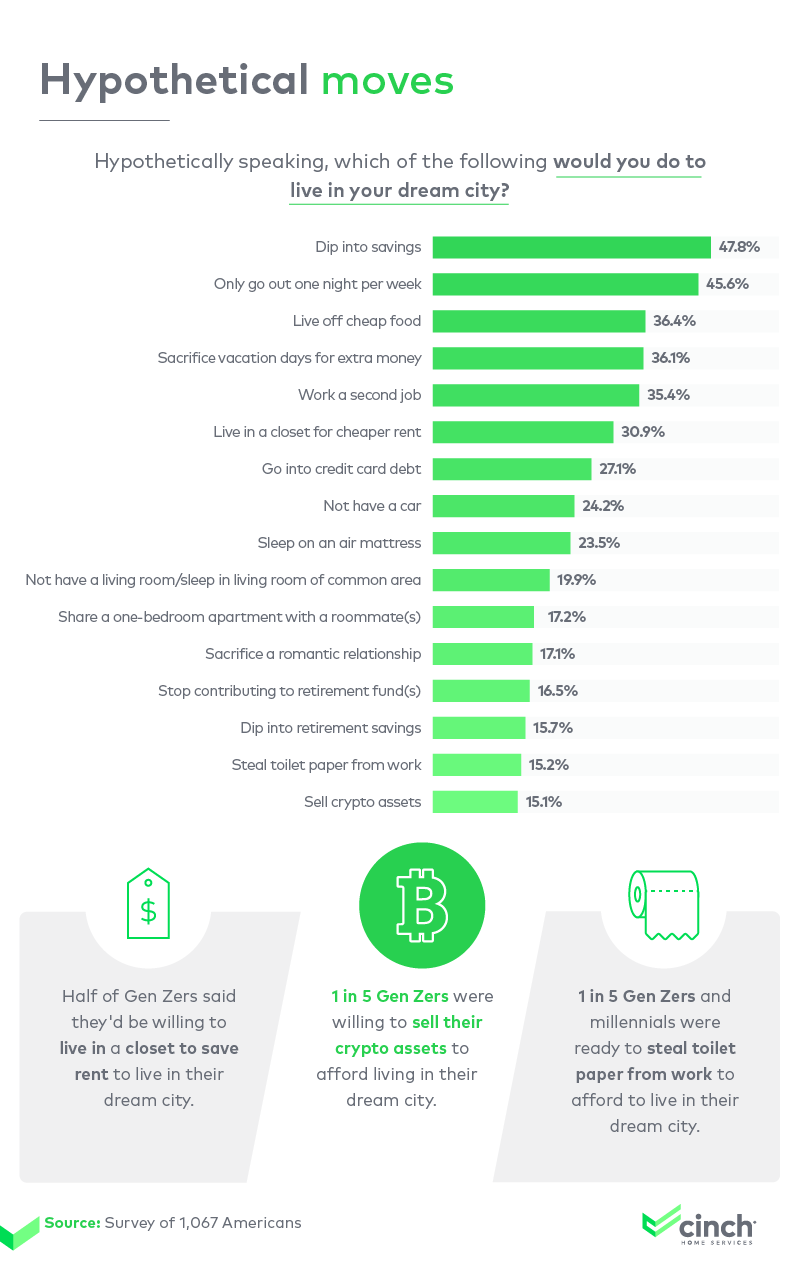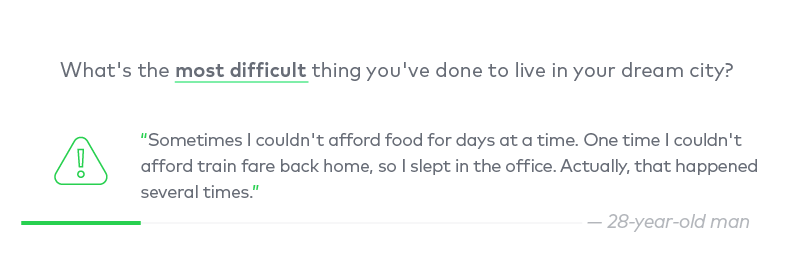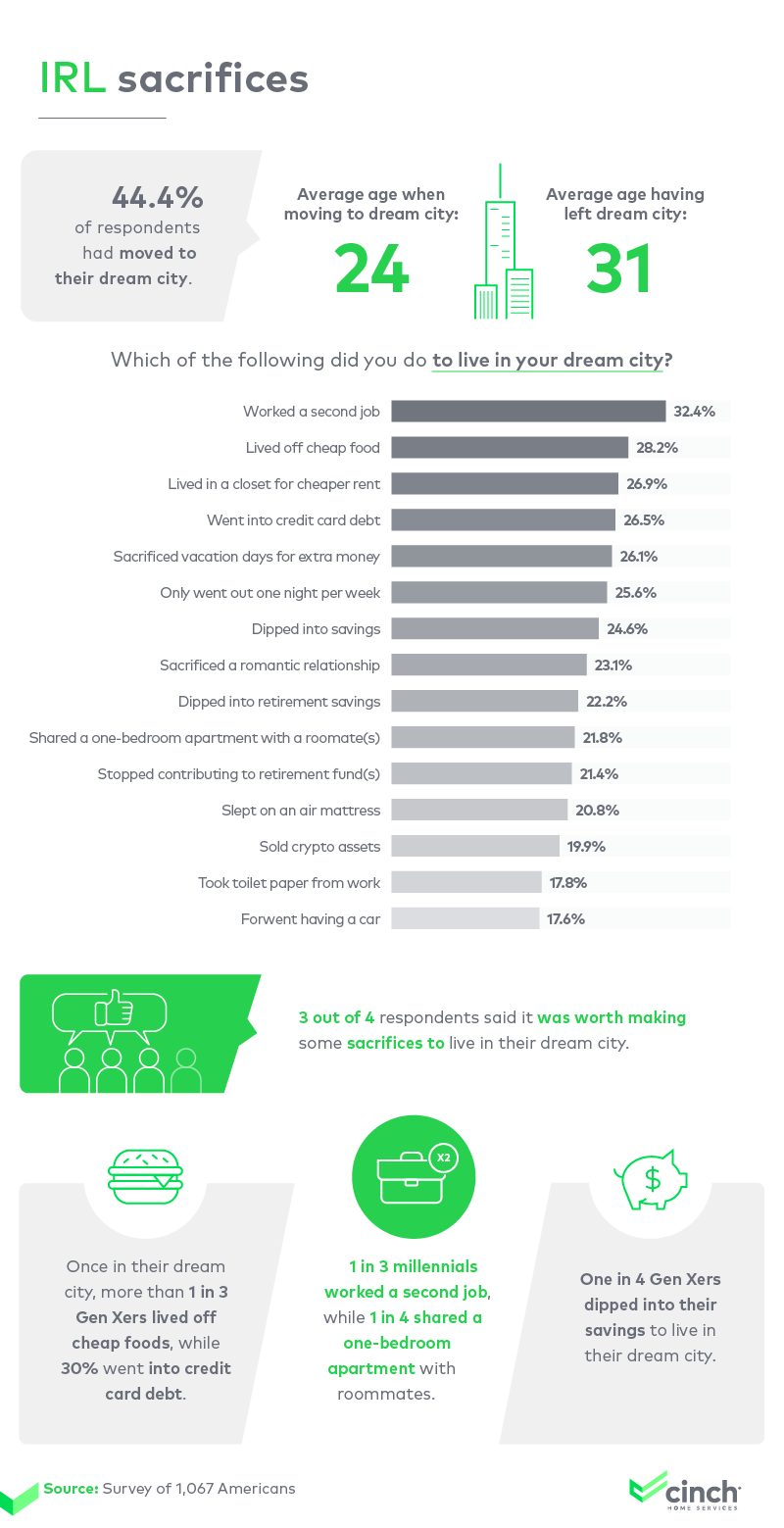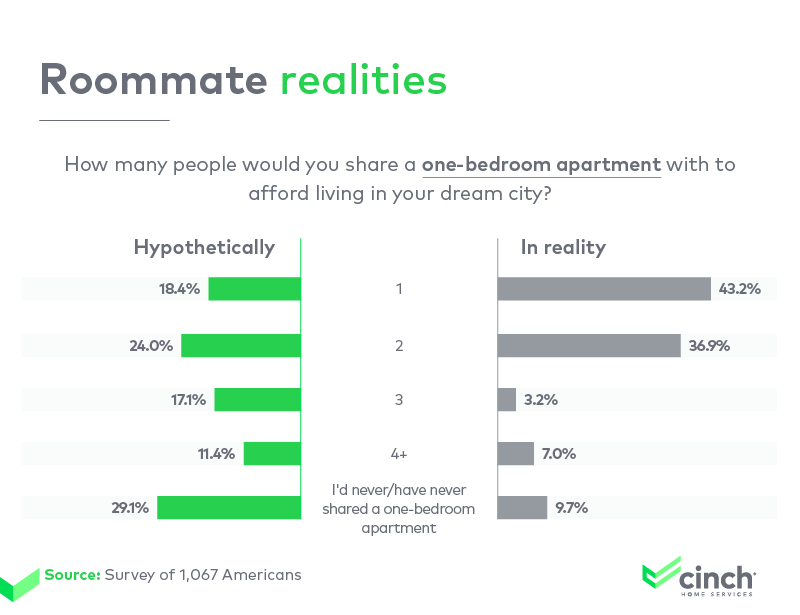- Almost 18% of people stole toilet paper from work to afford living in their dream city
- Almost 9 out of 10 people living in their dream city shared a 1-bedroom apartment
- New York City, San Diego and Los Angeles were the top three dream cities in the U.S.
Over a quarter of Americans living in their dream city admitted to having lived in a closet to afford it
Most people have a dream city they would make sacrifices to live in. For many, a dream city is one that provides the ideal location for the ideal lifestyle. Though sacrificing one's soul is (hopefully) not a prerequisite to living that dream, it's likely that compromises will factor in to the equation. To explore what these might be, we surveyed 1,067 Americans about their dream cities and what makes them so attractive—and what they would do or have already done to live there. Read on to learn more!
What makes a dream city?
Before delving much further, it's crucial to understand what we mean by "dream city." The first section of our study addresses a few key questions: Where are these so-called dream cities? And what are their defining qualities?

In order from most to least popular, our respondents' top 10 dream cities were as follows: New York City, San Diego, Los Angeles, Denver, San Francisco, Chicago, Dallas, Miami, Colorado Springs and Austin. It's certainly no surprise that New York City, with its wealth of entertainment and cultural opportunities and its reputation as the world's finance and fashion capital, ranks at the top of this list. San Diego's beautiful beaches and Los Angeles's alluring fame likely factor into their high ranking.
These are some of the features that make each city stand out, but what qualities do they have in common? To find out, we asked respondents about the aspects of their dream city that made it worth the sacrifice required to move there. The top five responses were as follows: culture (53.7%), entertainment options (48.7%), green spaces and outdoor activities (45.2%), job opportunities (42.1%) and a warmer climate (40.5%).
When you take into account millennials placing importance on public transportation, it makes sense for New York City and San Diego to come in at numbers 1 and 2 respectively on the list of dream cities. New York has it's famous subway system as well as plenty of buses, and San Diego has the trolley system.
Financing the big move: perceptions
Now that we know the most popular dream cities in America—and what makes these cities so dreamy in the first place—let's look at what the prospect of living in these places means to people. We asked our respondents what they would sacrifice in order to make their fantasy move.

The top five most popular sacrifices were dipping into savings accounts (47.8%), only going out one night per week (45.6%), living off cheap foods such as beans, rice and ramen (36.4%), sacrificing vacation days (36.1%) and working a second job (35.4%). Thankfully, tasty, affordable eats can even be found in respondents' top dream locale.

Gen Zers were the most willing to make less popular sacrifices. For example, half of Gen Zers were willing to live in a closet in order to compensate for expected expenses—a result that was significantly higher than the overall average. Gen Xers were notably less willing to go into credit card debt in order to make the big move, with only 1 in 5 hypothetically willing to do so. These figures make sense when one considers that older Americans are more likely to be responsible for dependents than young ones.
Living the dream?
Next, we asked respondents that had lived in their dream cities about the real-life sacrifices they had made to afford doing so.

Just over 44% of respondents had actually moved to their dream city, on average, arriving at 24 years old and leaving at age 31. Most notably, results showed only 24.6% of them had to dip into their savings, in comparison with the 47.8% of respondents who claimed they would hypothetically do so. Despite this reassuring statistic, experts still suggest moving to more affordable cities in order to save on housing costs and avoid depleting savings accounts.

Additionally, it turned out that 32.4% of respondents had worked a second job, making it the most common reality of living in one's dream city. Although an even higher proportion of respondents said they'd hypothetically be willing to do this, it's interesting to see that taking on extra work shifted from the fifth-most to the most popular sacrifice when it came time for respondents to put their dream into action. The risk of this hustle culture, however, is having a limited social life and missing out on the things that made the city attractive in the first place.

Notably, just over 1 in 4 respondents admitted to having lived in a closet to save money. While this is illegal in most states and municipalities, respondents still took to this extreme measure to afford living in their dream location.
Too many roommates?
Next, we asked respondents about their hypothetical and actual living arrangements and got a sense of just how much congestion they were willing to put up with.

When it came to sharing a one-bedroom apartment in order to afford living in their dream city, it appeared respondents weren't particularly keen on doing so. While many aren't keen on sharing their space within their dream city, the lack of affordable housing in many major cities means bunking with at least one other person in order to save.

For those who don't mind the idea of sharing a 1-bedroom apartment, just take care to look after yourself and your well-being, as overcrowded living conditions may lead to detrimental effects on mental health.
Worth it for you?
Generally speaking, it's easier said than done to uproot your current lifestyle in exchange for a perceived dream life. This explains why there were rather drastic discrepancies between hypothetical scenarios and lived experiences. For many people, living in their dream city was expensive and required some significant sacrifices. As we've learned from respondent testimonials, whether the dream was worth it varies from individual to individual.
If one thing is clear, it's that expectations and realities are not always the same. When it comes to finances, you need to be ready for anything. Fortunately, Cinch Home Services has you covered. Cinch is a one-stop shop for plans to protect your home appliances and built-in systems. We provide you with the plans and leave the decision making to you. Whatever scenario your household may encounter, cinchhomeservices.com is here to support you.
Methodology and limitations
This study uses data from a survey of 1,067 Americans. Survey respondents were gathered through the Amazon Mechanical Turk survey platform where they were presented with a series of questions, including attention-check and disqualification questions. Participants incorrectly answering any attention-check question had their answers disqualified.
48.7% of respondents were men, while 50.6% were women. Less than 1% of respondents identified as nonbinary or another gender. Respondents ranged in age from 18 to 77 years old with an average age of 39. Gen Zers accounted for 16.4% of respondents, millennials for 38.4%, Gen Xers for 28.7% and baby boomers for 16.5%. This study has a 3% margin of error on a 95% confidence interval.
Please note that survey responses are self-reported and are subject to issues, such as exaggeration, recency bias and telescoping.
Fair use statement
It's always good to dream, and it's certainly helpful to discuss your dream life. If you find our data useful, feel free to share the knowledge. Just make sure you do so for noncommercial use and provide a link back to our site.
